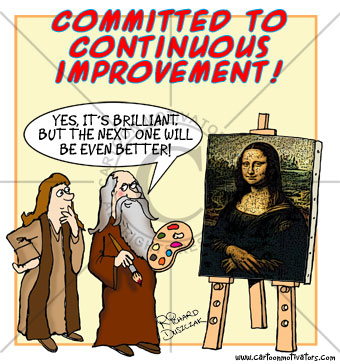Kaizen: How to Get 1% Better Every Day for a Better Body and Bank Account
A Guest Post by Tarek Roumie
Unle ss you are Superman or Wonder Woman, chances are you have something to improve in some aspect of your life.
ss you are Superman or Wonder Woman, chances are you have something to improve in some aspect of your life.
When first introduced to the term kaizen in “The Monk Who Sold His Ferrari”, I was blown away.
The term “kaizen” is Japanese for “improvement”. But the deeper meaning of the word refers to constantly thriving to improve in everything we do. Within this lies our eventual success.
Fitness itself is considered self improvement, yet most of us get lost somewhere along the path to our goals and kaizen begins to suffer.
Let's look at kaizen from another perspective. The game of life.
Without constantly improving, we end up going nowhere and are stuck fighting the diseases of mediocrity and boredom (Yes, boredom is a disease).
Kaizen will make you remarkable.
The beauty of kaizen is that it can easily be applied to every aspect of our lives, including fitness.
Let's look at our training first.
Ask yourself: Has my squat and deadlift gone up? Have I ran the 400m faster this month after following a certain program? If not, get back to the drawing board.
And what about eating? You're in luck: making better food choices is the simplest form of improvement for your health. If you have a lot of bad habits, try eliminating them at a slow pace as to not create a state of overwhelm.
Your relationship with food needs to be a relaxed one. The more you stress yourself, the higher the chances are of failure.
In addition to training, we can all “program” ourselves to practice kaizen by following four simple techniques.

1. Set Short Term and Long Term Goals. Review them Constantly.
Without goals, we have no purpose. Write them down, review them, and measure yourself against them. Did you achieve your goals? If not, why not? How can you improve yourself and do better next time?
Bojan Kostevski, MD, has a must-read manual on setting realistic goals and achieving them. His piece can be found here:
http://www.lift-heavy.com/goal-setting-manual/
2. Immediate Impact List.
Keeping an immediate impact list (IIL) will help you build positive habits, develop accountability, and accelerate your productivity.
By ticking everything on your list (maximum 10 points), you will have assured you are improving and getting closer to your goal.
Let me show you what I mean -- here's an example of my current goal:
Short Term Goal (December 2012) :
Fitness – Deadlift 315 for 3 reps, weigh 160ibs 10%bf
Business - Have Start Up Business ready to ship
Self – Meditate 30 minutes a day
Here's my IIL for the day -- notice each point takes me closer to one of my goals:
- Wake up 6:00am
- Meditate 10 minutes twice (morning and evening)
- Hit my target macro nutrients.
- Deadlift 315 for 1 rep.
- Work on finance of start up
- Read 2 chapters of Seth Godin's “Tribes”.
3. Log Book For Training and Daily Reflection.
Keep a personal diary noting events of importance, and a daily reflection. Periodically, look over what you have done in the past. What can you learn from this? Was a certain method more effective at taking you to your goals? Are there any tasks not taking you to your goal, that you should drop for something more productive? Analyze yourself and decide exactly what helped you in your journey to achieving your goals.
4. Smile.
Seriously. You have to be positive if you want to improve your situation. If you are enjoying what you do and doing what you enjoy, why should you not thrive to grow and become better?
Kaizen and the art of continuous improvement are fundamental in achieving our goals. Nobody gets anywhere standing still.
How would you feel if you have been benching 135 pounds for 2 years with no signs of change or improvement whatsoever?
Thrive for greatness, and do everything you can to achieve it.
Tarek Roumie is an aspiring fitness enthusiast, writer and personal trainer. Having been involved in different sports over the past few years at university level, understanding that there are many different ways to accomplish goals has led him to believe that there are no “right or wrong” way rather only paths that suit our specific needs. By also making things simple and easy to understand, he hopes to help people of all levels feel that fitness is not about suffering to achieve your goals, but rather enjoying the journey to a more awesome lifestyle.
Love this article? Click here to share it with your friends on Facebook.
Click here to claim your free online course, Mindfulness Made Simple.
Want to contribute? Email thewallenway [at] gmail [dot] com with a 50 word summary of your blog, story, list post, or work of art.
Tags: kaizen


